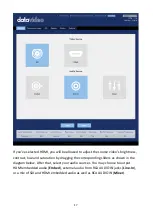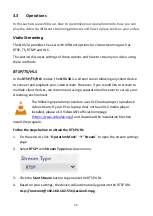
30
Level
ID
Max. Video
Bitrate in
kbits/s
Max Frame
Size in
macroblocks
Max decoding
speed in
macroblocks
per second
Resolution, Frame Rate
(Max Stored Frames)
3.1
14000
3600
108000
720×[email protected] (13)
720×[email protected] (11)
1,280×[email protected] (5)
3.2
(HD)
20000
5120
216000
1,280×[email protected] (5)
1,280×1,[email protected] (4)
4.0
20000
8192
245760
1,280×[email protected] (9)
1,920×1,[email protected] (4)
2,048×1,[email protected] (4)
4.1
(FHD)
50000
8192
245760
1,280×[email protected] (9)
1,920×1,[email protected] (4)
2,048×1,[email protected] (4)
Entropy
There are two coding options available for generating H.264 content:
CAVLC (Context-Adaptive Variable Length Coding)
CABAC (Context-based Adaptive Binary Arithmetic Coding)
CABAC encoding provides a 7-10% quality improvement over CAVLC but requires an
extra 10-15% CPU. CABAC encoding is only available in H.264 Profiles Main & High.
When targeting at low-powered devices, such as older cell phones and tablets, we
recommend the Baseline Profile that uses CAVLC which requires less computing
power.
GOP
GOP pattern with longer GOP length encodes video very efficiently. Shorter GOP
lengths usually work better with video that has quick movements, but they do not
compress the data rate as much. Depending on your applications, you can select 16
GOP sizes ranging from 1 to 255.
255
240
200
120
100
60
50
Summary of Contents for NVS-34
Page 1: ...NVS 34...
Page 34: ...34...
Page 58: ...58...
Page 60: ...60 7 Dimensions All measurements in millimeters mm...
Page 62: ...62 Notes...
Page 63: ...63 Notes...
















































